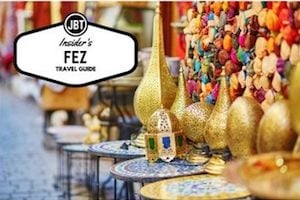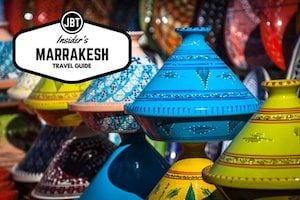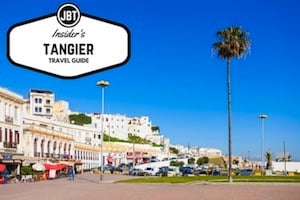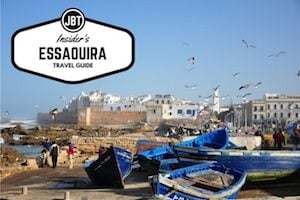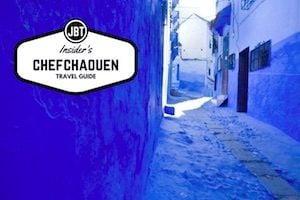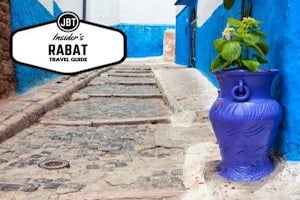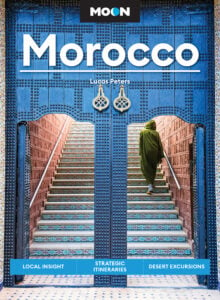It’s a common refrain heard around the world: “It’s not easy being green.” In bright contrast to the Kermit dirge bemoaning the color green, the hillside town of Ouazzane, Morocco celebrates green. Greens of every tone are splashed across the medina walls and reflected in the fields and olive groves that surround the town. So, if you find yourself in this hillside medina on the edge of the Rif Mountains, the fact remains: It’s easy being green! Consider a road trip to Ouazzane!
The unique, neon-mint green medina of Ouazzane is a bit of an undiscovered gem that is worth a detour for curious travelers and those with a bit more time. Located about an hour and a half south of Chefchaouen and about two and a half hours north of Fez, Ouazzane comes as a bit of a surprise hidden by the rolling hills and olive groves on this cross country route.
I am not quite sure why we decided to go to Ouazzane, but I suspect it was to take a friend and a friend’s friend market shopping under the guise of showing me some local textiles and djellaba makers. We did return with several lovely woven wool throws, not to mention kilos of olives, olive oil and a very lively chicken in the back of the car! In the end, “why” we went is less important than the fact of us hitting the road from our home in Asilah, along the Atlantic coast, and heading inland for Ouazzane.

Sometimes in Morocco it is best not to question why, and just embrace the moment.
The Road Trip Ouazzane
After the prerequisite early morning coffee (it probably wasn’t that early, but things in the Asilah medina can be a little slow to start) we picked up the aforementioned friend-of-a-friend who apparently knew the way, and headed out of town on the Larache road (N1). At some point we turned left and headed for the hills — the southwestern foothills of the Rif Mountains to be exact. We did have to stop and ask directions once or twice despite our trusty guide, so I would recommend a map, even if all you use it for is to point at where you want to end up.
Ouazzane Quick Fact: Ouazzane is also known locally as Dar Dmana, Arabic for “House of Safety.” If you do need to ask directions it might be best to use Dar Dmana as a reference.
The old cliché of “life’s a journey, enjoy the ride” was made for this trip. Driving through the countryside alongside olive groves and fields punctuated by fig trees is lovely. There are several small Olive Press Cooperatives along the road. On this particular road trip, we didn’t stop, but I am definitely putting a stop at one (or a few!) of these cooperatives on the agenda for my next visit.
Locally produced honey and oil is also sold by farmers along the road, but we waited to do our shopping until we got to the town market where we were spoiled for choice with an array of fresh local beldi produce. Tasting and deliberating with the women traders over who had the best olives and oil was an animated, contested discussion. And after some heated exchanges, and a little more tasting, we settled on our oil of choice.
Besides honey and olive oil, this region of Morocco is best known locally for its wool production. And I can assure you, if a wool-woven djellaba is what you are after, this is your town. A lot of the winter-style djellabas you see on display in medinas around the country are in fact produced here. The strong regionalism and tribalism of textile design in Morocco is something I love and it is always interesting to discover how local environment and resources impact on the weavers creativity. There was a lot of this on display in Ouazzane.
Though I didn’t purchase a djellaba on this particular road trip, I did purchase a couple of blankets in a style I hadn’t really seen along the coast. That alone made the two hour drive from Asilah worthwhile for me.

Ouazzane is also well-known around Morocco, and beyond, as a spiritual center as there are several burial sites and tombs of saints (marabouts) situated here. It is a place of significance for Muslims, Sufis and Jews, and remains a place of religious pilgrimage. There are over forty significant burial sites placed in the town and its surrounding hillsides. So although the town is not on the typical tourist bucket list, it has always been and still is an important stopover for those on a spiritual journey.
One of the most famous people buried here is Moul Anrhaz, an 18th century rabbi who lived in Ouazzane — his burial site is said to be a place of miracles and a stop for many Jewish pilgrims.
In direct contrast to a lot of other medinas you will encounter (in particular its blue counterpart further along the Rif Mountains, Chefchaouen) you might be one of only a handful of tourists in Ouazzane. While we were there, I didn’t see a single traveler. Not one! And in an ancient Moroccan medina, imagine that! That in itself makes it worth a visit.
Despite the lack of tourist trappings the town felt friendly and easy to navigate, the medina itself is quite small and it doesn’t take long to meander through it and find your bearings. Merchants are pretty laid back and you aren’t likely to be hit with the hard sell as likely will in the old cities of Fez and Marrakesh.
I suspect the untouched nature of Ouazzane might change in the coming years as I have heard murmurs of a bit of a PR campaign that may happen. The drive is rumored to put Ouazzane on the spiritual tourist map.
There is a downside to this relative respite from tourists — hotels and restaurants are thin on the ground and limited in choice. So… Moroccan café-style street food was the order of the day.
Ouazzane is a very doable, and in my opinion recommendable, day trip from Chefchaouen, Asilah, or Fez. It’s a great day out in the country where you can enjoy the fresh Rif Mountain air while discovering some local olive oil and steering clear of the madding crowds. You could also consider including Ouazzane as an en-route stop on your way between Chefchaouen and Fez where a meandering cross-country route is something a pastoral treat.
We arrived back in Asilah a little travel weary but with all the ingredients (apologies to that aforementioned chicken) for a wonderful tagine, scented with the aromatic olive oil and fresh olives and herbs we had bargained hard for that morning in the Ouazzane market. Sitting on our roof terrace on a spring evening, listening to the waves of the Atlantic Ocean breaking against the ancient medina walls of Asilah, I wrapped that handwoven blanket snug around my shoulders, content in the knowledge of a day well spent.
About the Author
 Pauline de Villiers Brettell is a freelance writer and designer who lives between the UK and Morocco. When in Morocco she is based in the small seaside village of Asilah, and spends time working with local weavers and sourcing textiles in between attempting to grow enough olives for an annual supply of olive oil! She writes about all of these things — the olives, the carpets, and other elements of design inspiration on her blog Tea in Tangier: www.teaintangier.com.
Pauline de Villiers Brettell is a freelance writer and designer who lives between the UK and Morocco. When in Morocco she is based in the small seaside village of Asilah, and spends time working with local weavers and sourcing textiles in between attempting to grow enough olives for an annual supply of olive oil! She writes about all of these things — the olives, the carpets, and other elements of design inspiration on her blog Tea in Tangier: www.teaintangier.com.


